- Home Page
- Kite Plans
- Diamond Shape Kite
Make a Diamond Shape Kite
Tiny, Medium, Large, or Huge
When we started this site, a tiny diamond-shape kite was one of the very first designs we came up with. This diamond was made from two BBQ skewers with a clear-plastic sail and matching tail.
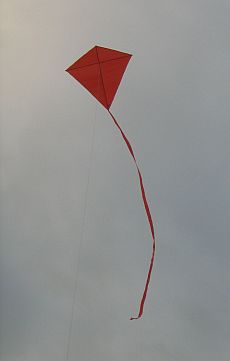 MBK Simple Diamond
MBK Simple DiamondThe 1-Skewer Diamond was quickly off the drawing board and into the air! Against a gray cloudy background, the little kite could be difficult to spot because it was so see-through. However, near sunset it would transform remarkably, with the sun's rays lighting up the plastic sail and tail like a neon light!
We found the 12 cm (12 in.) variety of bamboo skewers worked well with the points snipped off. Later, I made the kite more visible by doing the sail in orange plastic and using a simple ribbon tail of black plastic. It looked good!
Next up in size comes the 2-Skewer Diamond, which you could consider to be a medium size. On a 20-pound Dacron line, it is a good performer up to 300 feet of altitude or so. Beyond that, there is quite a lot of sag in the line. However, you could probably fix that by using even lighter line.
Then we started making larger kites like the 1.2 m (4 ft.) span Dowel Diamond. This one is superb in very light winds and will even go right overhead if there is just a whiff of warm rising air underneath it!
Just like the 1-Skewer designs were doubled into 2-Skewer designs, I did a similar thing to the Dowel designs. Among other types, the 2.4 m (8 ft.) span Multi-Dowel Diamond was created!
And I mustn't forget the little Paper Diamond too. It's the second kite in the Paper Series. These kites feature rigid spars, but everything is formed from copier paper and sticking tape! Testing ensures that each paper kite flies over 200 feet up, can stay up for at least 20 minutes unaided, and will last for more than three hours of flight time.
Finally, for those who want to whip up something super quick and easy, there was the Simple Series of just three kites. The Simple Diamond is the first described below. There is a photo or two and a video of each MBK Diamond shape kite. This illustrates the end result, in case you decide to use any of our kite-making e-books.
On this site, there's more kite-making info than you can poke a stick at. :-)
Want to know the most convenient way of using it all?
The Big MBK E-book Bundle is a collection of downloads—printable PDF files which provide step-by-step instructions for many kites large and small.
That's every kite in every MBK series.
A lot of people have shied away from making my Skewer kites due to their complexity and need for gluing. Hence I did a small series of ultra basic kites, including the Simple Diamond. There it is at the top of this page and in the video below.
The spars are about 1 meter (nearly 3 1/2 feet) long. There's no bridle and no gluing! In light winds, it can be flown on 20-pound line, but we usually use 50-pound line just to be safe.
With no bow or dihedral, this kite tends to bob around a lot, particularly in rough air.
In keeping with absolute simplicity, the tail for this diamond
shape kite is just a single ribbon of the same plastic used to make the
sail.
1-Skewer Diamond Kite
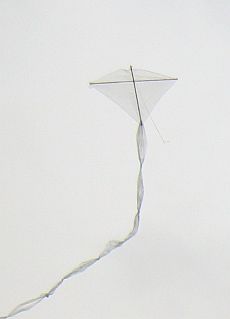 Original 1-Skewer Diamond
Original 1-Skewer DiamondThis 1-Skewer Diamond looks a bit worse for wear in the photo, with some bits missing near the nose. Diamonds just keep on flying though. Each spar is a 29 cm (11 1/2 in.) bamboo BBQ skewer.
The original was made from clear freezer-bag plastic, which made it almost impossible to see against a gray sky. It's a different story when backlit by the setting sun, though.
With a long tail, this little diamond shape kite has a surprisingly good wind range. See how we have made the tail from several loops of plastic, cut from bags. Each loop is knotted to the next one, making something more interesting than a simple ribbon.
We flew this kite on 50 meters (150 feet) of 20-pound line. It doesn't need that strength, but we also flew our 2-Skewer Series kites on the same line.
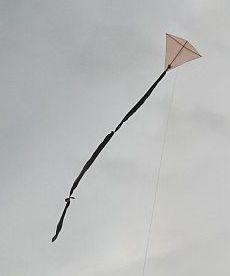 MBK 1-Skewer Diamond
MBK 1-Skewer DiamondHere's the latest version of the 1-Skewer Diamond, in orange garden-bag plastic.
The tail is cut from a cheap black garbage bag. Actually, we knotted a few lengths together as you can see. The long tail ensures that this quite small kite can cope in gusty breezes from quite light to almost fresh in strength.
Check out the video below, which was taken from underneath and just a little upwind of the kite. The breeze was moderate and gusty as it almost always is inland.
2-Skewer Diamond Kite
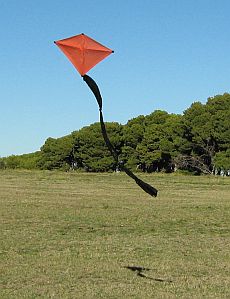 Original 2-Skewer Diamond
Original 2-Skewer DiamondThe 2-Skewer Diamond is, as the name suggests, exactly twice as tall as the 1-Skewer design. This gives it four times the sail area with not much more than double the weight. Hence, it's pretty good in light winds.
The diamond-shape kite pictured has two-ply plastic that makes it a little heavier, but it still flies great. Like most diamonds on a simple two-point bridle, this kite moved around quite a lot during flight.
We did have an unusually sedate flight with it once, when a very smooth cool airstream flowed across the local reserve where we were flying.
It just sat there at around 100 feet, with barely a wiggle.
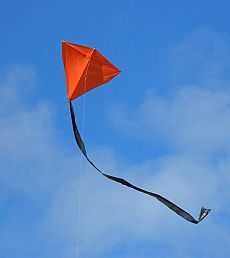 MBK 2-Skewer Diamond
MBK 2-Skewer DiamondHere's a photo of the latest 2-Skewer Diamond. Shaped a little like an Eddy kite, it doesn't require a lot of tail.
The video below shows this kite in a gusty light breeze. Some of the gusts are strong enough to send it into a loop or two.
After this video was taken, a small hole was cut in one side of the sail to correct its tendency to lean to one side as the wind strength increased. That was just an experiment, and it didn't turn out to be very effective.
Dowel Diamond Kite
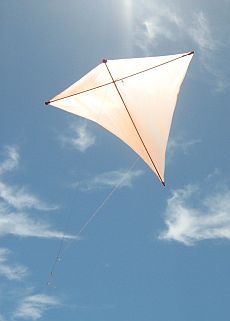 Original Dowel Diamond
Original Dowel DiamondFor quite a while, this was the largest of the MBK Diamonds—the Dowel Diamond. This one was designed from the start to be tailless. In fact, it is loosely based on the famous tailless Eddy kite.
I can't help thinking it looks a little strange just sitting there in the air. We are so conditioned to seeing the diamond shape with a tail.
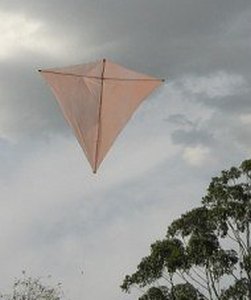 MBK Dowel Diamond
MBK Dowel DiamondThe MBK Dowel Diamond is a reliable flier in light and moderate breezes. Like most diamonds, the flying-line angles are modest, but it climbs easily to 400 feet if you let enough line out.
Size? It's twice as tall as the 2-Skewer Diamond, so that's four times the area.
Compared to the 1-Skewer Diamond shape kite, the Dowel Diamond has 16 times as much area!
Check out the video below:
Multi-Dowel Diamond Kite
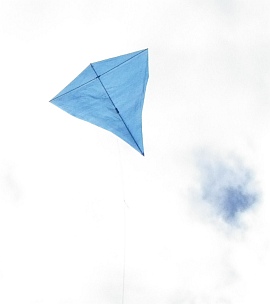 MBK Multi-Dowel Diamond
MBK Multi-Dowel DiamondFinally, here's the big daddy of them all, the MBK Multi-Dowel Diamond.
Despite its huge size, this is really a fairly light-wind kite. It moves slowly and steadily around the sky on as much line as you are willing to let out.
Get set for some spectacular climbs overhead if any rising air comes through!
Shall we run those sail area figures again. At double the width and height of the Dowel Diamond, the Multi-Dowel design has:
- 4 times the sail area of the Dowel Diamond
- 16 times the sail area of the 2-Skewer Diamond
- 64 (!) times the sail area of the 1-Skewer Diamond
See the huge diamond in action in the video below:
That's about it for this page on the diamond-shape kite—in many convenient sizes!
I hope you enjoyed the pictures and information.
As mentioned earlier, there's more kite making on this site than you can poke a stick at. :-)
Want to know the most convenient way of using it all?
The Big MBK E-book Bundle is a collection of downloads—printable PDF files which provide step-by-step instructions for many kites large and small.
That's every kite in every MBK series.
